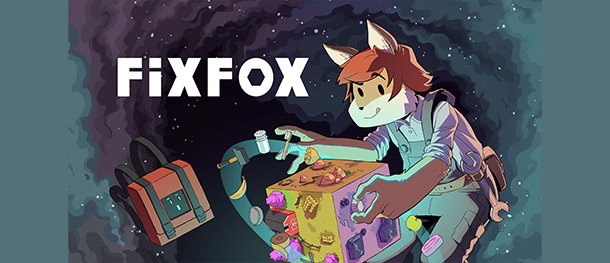Review: FixFox
There is something of a genre which encapsulates the tactile satisfaction of flicking a light switch, removing a screw, or snapping a RAM stick into your PC. GNOG was a notable example in recent memory of a game which did this so well, having you turn cogs and pull strings to uncover little dioramas so absurd they’d make no sense in the real world. Looking at the screenshots of FixFox, I think I went into it expecting that type of game.
You do after all play as Vix, a “spliced” human-fox hybrid with an aptitude for fixing things in.. unconventional manners. You’re not very good, basically, and on the brink of redundancy, until our AI supervisor sends us on one final mission to prove ourselves. And we do prove ourselves – a sloppy mechanic yet generally useful oddball on a dessert themed planet – skipping along fixing things from fans to blenders to televisions, taping up loose pendulums with postage stamps, liberally applying olive oil to lubricate motors and using bananas to bridge the potassium contact points. I never knew toaster internals were so complex!
So off we go to Karamel, “we” being Vix and our toolbox companion, Tin, and to both of their surprise, four celebrity AI’s too, sneaking aboard for a furtive and extraordinary adventure. There’s a fair bit of fixing to be done on a planet wrought with aristocratic overlords, of which have outlawed the act of repair, and in typical tyrannical fashion they’re named “The Order”. Their rebellious counterpart, The Pirates, hide their loot in crevices and cracks all across the land, of which we use for repair, and by which we annoy them for swiping their booty! They’re tangential, really, as quickly the scavenge and repair gameplay I presumed would take centrestage falls to the wayside to further a narrative focussed on a select few characters, pondering on the foibles of AI, and ultimately one of union.
Karamel itself is a pretty place, not the bubblegum sweet, fluorescent colour you’d expect given its sugary name, it’s actually quite diverse. We start in the Salty Desert, the arid countryland, filled with many yellows, sparse foliage and tons of cacti. The latter, along with some sunflowers in the croplands, sway gently, revealing their impressive heights as the game’s top down perspective often shrouds the true depth of the environment. It can be an issue at times, not so much in a gameplay sense, but in identifying what something is meant to be; seeing one side of something only reveals so much. FixFox makes use of a day and night cycle, and the moments where it fades into and out of sunrise can look particularly pretty and idyllic, even in some of the wasteland areas. Where FixFox’s really shine is through close up sections – or in the increasingly sparse fixing puzzles where objects like plasters, bananas, coins and spatulas can appear more realistic. Still wholly cartoony, and intentionally look hand drawn, but the added detail is appreciated. The only problem with the style – and this goes for pixel art in general – is the possibility that something isn’t easily identifiable, and while bigger objects perhaps border that line of imperceptibility, larger chunks of terrain often use broad strokes for their sprites and fail to blend into its surrounding environment and objects, meaning quite often to start with, I’d be riding into walls thinking it was just a slightly different coloured flooring.
Like day moving into night, the sounds of Karamel change too with different biomes. Our starting area employs a twangy guitar, as if we were transported straight into the wild west. The next, a placid woodland area, is matched with gentle and high pitched wind instruments, sending us into a fairy-like coma. Sweet Fields spruces things up again, a rootin-tootin tune with instruments galore, all upbeat and jolly. I adore FixFox’s soundtrack, which is auspicious given it’s so prevalent. Everywhere you go, travelling the open wilds between settlements, music gushes out, and it sets the tone perfectly, no more apparent than in The Library, a sedative track incorporating a stern “shhh!” at intervals.
It’s a soundtrack which reaches into every corner of the game’s orbit, and it was a surprisingly long one at that. Spanning around ten hours, FixFox was far bigger than I expected; my expectations being a quirky hour or two GNOG-style puzzle game, but FixFox almost abandons those quaint aspirations for a true adventure. The result is something with a narrative focus, still in the puzzle realm, but plagued with backtracking and a general lack of focus. The aforementioned factions controlling the planet for example are forgotten about after the first hour. Repairing machinery sticks throughout, but with a greatly diminished role and evolves very little. To start with, fixing something required identifying the issues and then scavenging for tools with those correct parameters. Coins are given the “flat” classification, as a result can be used in the same way a screwdriver can. Plasters are the tape of the flesh, and on Karamel can be used to insulate wiring, while donuts are sorta similar to gears, right? Got a cog missing? Slap a donut in there and it’s as good as new. It’s an affable system, inherently funny and pleasant to use odd objects to solve problems, but FixFox aspires for something larger, as in its journey to that destination this system falls by the wayside, incorporating new tools as the game progresses but consequently bringing forth backtracking to acquire tools from prior biomes.
So what is this greater image FixFox is destined for? Well it’s one of adventure, a classic rescue mission with a troupe of diverse characters, most of which are AI but thankfully imbued with more humanlike charm than robotic lifelessness. My favourite part of FixFox’s writing is directly tied to these four companions, as we’re tasked with individual missions where we use their acumen to use powerful mechs. Each storyline shows how they came to be, like Naviko’s start as a ruthless military warlord, or Mediko’s troubled inception bowing to the desires of a cruel healthcare system. They’re relatively brief, and some less deep than others, but all illustrate the game’s willingness to dip into topics and dilemmas relevant to our lives now, and perhaps even more so as AI becomes more ubiquitous in the real world.
The bigger narrative is mostly a rescue mission, unearthing an ancestor frozen in cryogenic stasis and beginning a journey to find their missing brother. I was less interested in this story, in part due to a potential narrative strain involving race relations and how our frozen forebear comes to terms with having less attention placed on it than I would have liked. This is partly why FixFox feels somewhat bloated. The backtracking doesn’t help, but when the game has you travel to each area every so often to solve puzzles in the name of a more convoluted, less interesting plot, I feel like I could’ve done with a game half the size. “Esomath”, or esoteric math, is the key concept, a self-aware copout which the game uses to carry out most of its escapades. Complicated and understood by pretty much no one, esomath enables the game to do what it wants with its objectives, but leaves much to be desired when it comes to making what we do fun. Once introduced, you fall into a loop carrying out an esomath ritual, go to an area for some puzzles, and repeat. The narrative unfortunately relies on this too heavily, and in the pursuit of finding our target, hopping from area to area for esomath reasons is as far as the plot goes.
Outside of repairs, puzzles make use of the aforementioned mechs for some standard object manipulation challenges. Abandoned factories litter the map, and each AI wields the power to control mechs capable of removing or moving obstacles, and through their individual stories we unlock those powers, and thus later puzzles get more complex. While they are fun, they never quite reach a level of satisfactory challenge. One mech can pull stuff, another can dig, and another can drill, and you need to ascertain where to use them and in which order to get to the “heart” of the factory, which progresses the AI storyline. They’re simple and functional, but quite easy to figure out with little foreplanning. This is all to say that the “game” part of FixFox is a bit all over the place and unhoned. The Assemble With Care-style fixing puzzles are tangentially related to scavenging which has no relation to anything else, other than to have you move across the map several times.
But there’s another half to FixFox, one which is warm, kind and pleasant. The AI storylines are my personal favourite drivers of narrative, but even dialogue between NPC’s and, frequently, Tin, are humorous and cute. Weirdly, Vix themselves is silent, which seems baffling as it’s clear the developer has a talent for writing solid banter, so Vix’s withdrawn nature is a point which let me down. It really is a shame, as dialogue is presented in a palpable fashion, making full use of animation and font variety to establish different tones and volumes. Screaming in horror and screaming with joy are two very different things, and in FixFox you know which is which by which one is bouncing in rainbow colours.
I enjoyed my time with FixFox, but it was intermittent. What FixFox embodies is innocence and collaboration, its world existing where problems are still prevalent, but by and large people (and robots) caring for one another isn’t. It’s evident through every storyline, from the AI’s to unspliced frozen chap, that compassion is key to the game, and it portrays that effectively. It does so clearly, but the message is muddied by layers of “game” (for lack of a better word), “game” which in isolation works perfectly well, if a tad perfunctory, but strung together makes the experience feel unfocused.
Review by Will.







